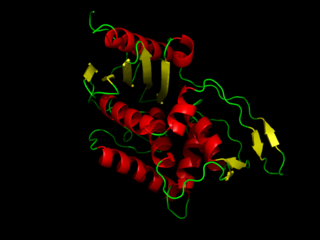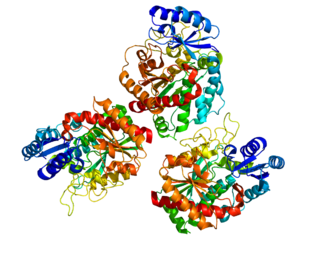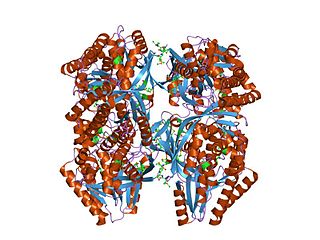Related Research Articles

DD-transpeptidase is a bacterial enzyme that catalyzes the transfer of the R-L-αα-D-alanyl moiety of R-L-αα-D-alanyl-D-alanine carbonyl donors to the γ-OH of their active-site serine and from this to a final acceptor. It is involved in bacterial cell wall biosynthesis, namely, the transpeptidation that crosslinks the peptide side chains of peptidoglycan strands.
Aspergillopepsin I is an enzyme. This enzyme catalyses the following chemical reaction

Carboxypeptidase E (CPE), also known as carboxypeptidase H (CPH) and enkephalin convertase, is an enzyme that in humans is encoded by the CPE gene. This enzyme catalyzes the release of C-terminal arginine or lysine residues from polypeptides.

Cathepsin A is an enzyme that is classified both as a cathepsin and a carboxypeptidase. In humans, it is encoded by the CTSA gene.

Carboxypeptidase B2 (CPB2), also known as carboxypeptidase U (CPU), plasma carboxypeptidase B (pCPB) or thrombin-activatable fibrinolysis inhibitor (TAFI), is an enzyme that, in humans, is encoded by the gene CPB2.

Adrenal ferredoxin is a protein that in humans is encoded by the FDX1 gene. In addition to the expressed gene at this chromosomal locus (11q22), there are pseudogenes located on chromosomes 20 and 21.

Carboxypeptidase N catalytic chain is an enzyme that in humans is encoded by the CPN1 gene.

Probable serine carboxypeptidase CPVL is an enzyme that in humans is encoded by the CPVL gene. The "CPVL" gene is expressed mainly in monocytes and macrophages, and it is located in the endoplasmatic reticulum and in the endosomal/lysosomal compartment. The distribution of CPVL suggests that the enzyme may be involved in antigen processing and the secretory pathway. Besides those macrophages-rich tissues, the heart and kidney also express high levels of CPVL mRNA.The enzyme is similar to the carboxypeptidases CATHA and SCPEP1, but no direct confirmation of the enzymatic activity was obtained so far. The exact function of this protein, however, has not been determined.

Carboxypeptidase A2 is an enzyme that in humans is encoded by the CPA2 gene.

Carboxypeptidase Z is an enzyme that in humans is encoded by the CPZ gene.

Selank is a nootropic, anxiolytic peptide based drug developed by the Institute of Molecular Genetics of the Russian Academy of Sciences. Selank is a heptapeptide with the sequence Thr-Lys-Pro-Arg-Pro-Gly-Pro (TKPRPGP). It is a synthetic analogue of human tuftsin.
The carboxypeptidase A family can be divided into two subfamilies: carboxypeptidase H (regulatory) and carboxypeptidase A (digestive). Members of the H family have longer C-termini than those of family A, and carboxypeptidase M is bound to the membrane by a glycosylphosphatidylinositol anchor, unlike the majority of the M14 family, which are soluble.

In molecular biology, the GHMP kinase family is a family of kinase enzymes. Members of this family include homoserine kinases EC 2.7.1.39, galactokinases EC 2.7.1.6, and mevalonate kinasesEC 2.7.1.36. These kinases make up the GHMP kinase superfamily of ATP-dependent enzymes. These enzymes are involved in the biosynthesis of isoprenes and amino acids as well as in carbohydrate metabolism. These enzymes contain, in their N-terminal section, a conserved Gly/Ser-rich region which is probably involved in the binding of ATP. The C-terminal domain of homoserine kinase has a central alpha-beta plait fold and an insertion of four helices, which, together with the N-terminal fold, creates a novel nucleotide binding fold.
Lysine carboxypeptidase is an enzyme. This enzyme catalyses the following chemical reaction:
Muramoyltetrapeptide carboxypeptidase is an enzyme. This enzyme catalyses the following chemical reaction
Zinc D-Ala-D-Ala carboxypeptidase (EC 3.4.17.14, Zn2+ G peptidase, D-alanyl-D-alanine hydrolase, D-alanyl-D-alanine-cleaving carboxypeptidase, DD-carboxypeptidase, G enzyme, DD-carboxypeptidase-transpeptidase) is an enzyme. This enzyme catalyses the following chemical reaction
Carboxypeptidase D can refer to one of several enzymes. A family of serine carboxypeptidases includes is an enzyme. This enzyme has an optimal pH of 4.5-6.0, is inhibited by diisopropyl fluorophosphate, and catalyses the following chemical reaction

Ghk.
Thermitase is an enzyme. This enzyme catalyses the following chemical reaction

Decynium-22 is a cationic derivative of quinoline, and a potent inhibitor of the plasma membrane monoamine transporter (PMAT), as well as all members of the organic cation transporter (OCT) family in both human and rat cells. However, it has little effect on high affinity monoamine transporters such as the dopamine transporter and norepinephrine transporter.
References
- ↑ Osterman AL, Stepanov VM, Rudenskaia GN, Khodova OM, Tsaplina IA (February 1984). "[Carboxypeptidase T--intracellular carboxypeptidase of Thermoactinomycetes--a distant analog of animal carboxypeptidase]". Biokhimiia. 49 (2): 292–301. PMID 6424730.
- ↑ Smulevitch SV, Osterman AL, Galperina OV, Matz MV, Zagnitko OP, Kadyrov RM, Tsaplina IA, Grishin NV, Chestukhina GG, Stepanov VM (October 1991). "Molecular cloning and primary structure of Thermoactinomyces vulgaris carboxypeptidase T. A metalloenzyme endowed with dual substrate specificity". FEBS Letters. 291 (1): 75–8. doi:10.1016/0014-5793(91)81107-j. PMID 1936254.
- ↑ Teplyakov A, Polyakov K, Obmolova G, Strokopytov B, Kuranova I, Osterman A, Grishin N, Smulevitch S, Zagnitko O, Galperina O (September 1992). "Crystal structure of carboxypeptidase T from Thermoactinomyces vulgaris". European Journal of Biochemistry. 208 (2): 281–8. doi: 10.1111/j.1432-1033.1992.tb17184.x . PMID 1521526.